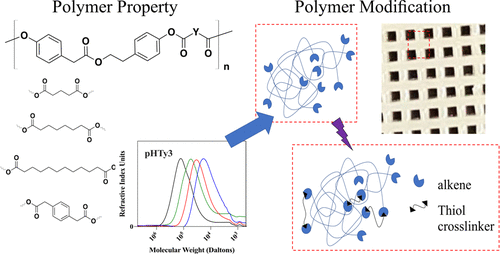当前位置:
X-MOL 学术
›
ACS Biomater. Sci. Eng.
›
论文详情
Our official English website, www.x-mol.net, welcomes your
feedback! (Note: you will need to create a separate account there.)
Tyrosol-Derived Biodegradable Inks with Tunable Properties for 3D Printing
ACS Biomaterials Science & Engineering ( IF 5.4 ) Pub Date : 2021-08-16 , DOI: 10.1021/acsbiomaterials.1c00464 Jarrod Cohen 1 , Cemile Kilic Bektas 1 , Andrew Mullaghy 1 , M Mario Perera 1 , Adam J Gormley 2 , Joachim Kohn 1
ACS Biomaterials Science & Engineering ( IF 5.4 ) Pub Date : 2021-08-16 , DOI: 10.1021/acsbiomaterials.1c00464 Jarrod Cohen 1 , Cemile Kilic Bektas 1 , Andrew Mullaghy 1 , M Mario Perera 1 , Adam J Gormley 2 , Joachim Kohn 1
Affiliation

|
Three-dimensional (3D) printing has emerged as a valuable tool in medicine over the past few decades. With a growing number of applications using this advanced processing technique, new polymer libraries with varied properties are required. Herein, we investigate tyrosol-based poly(ester-arylate)s as biodegradable inks in fused deposition modeling (FDM). Tyrosol-based polycarbonates and polyesters have proven to be useful biomaterials due to their excellent tunability, nonacidic degradation components, and the ability to be functionalized. Polymers are synthesized by polycondensation between a custom diphenol and commercially available diacids. Thermal properties, degradation rates, and mechanical properties are all tunable based on the diphenol and diacid chosen. Evaluation of material print as it relates to chemical structure, molecular weight, and thermal properties was explored. Higher-molecular-weight polymers greater than 50 kDa exhibit thermal degradation during printing and at some points are too viscous to print. It was determined that polymers with lower processing temperatures and molecular weights were printable regardless of the structure. An exception to this was pHTy6 that was printed at 65 kDa with minimal degradation. This is most likely due to its low melting temperature and, as a result, lower printing temperatures. Additionally, chemical improvements were made to incorporate thiol–alkene click chemistry as a means for postprint curing. Low-molecular-weight pHTy6 was end-capped with alkene functionality. This material was then formulated with either a dithiol for chain extension or tetrathiol for cross-linking. Scaffolds were cured after printing for 5, 15, 30 and 60 min intervals where longer cure times resulted in a tougher material. This design builds on the library of biologically active materials previously explored and aims to bring new biomaterials to the field of 3D-printed personal medicine.
中文翻译:

酪醇衍生的可生物降解油墨,具有可调节的 3D 打印特性
在过去的几十年中,三维 (3D) 打印已成为医学领域的一种宝贵工具。随着越来越多的应用使用这种先进的加工技术,需要具有不同特性的新聚合物库。在此,我们研究了基于酪醇的聚(酯-芳基化物)作为熔融沉积建模 (FDM) 中的可生物降解墨水。酪醇基聚碳酸酯和聚酯已被证明是有用的生物材料,因为它们具有出色的可调性、非酸性降解成分和功能化能力。聚合物是通过定制二元酚和市售二元酸之间的缩聚反应合成的。热性能、降解速率和机械性能都可以根据所选的二酚和二酸进行调节。材料印刷的评估,因为它与化学结构、分子量、并探索了热性能。大于 50 kDa 的高分子量聚合物在打印过程中会出现热降解,并且在某些点太粘而无法打印。确定具有较低加工温度和分子量的聚合物是可印刷的,而不管其结构如何。一个例外是 pHTy6,它以 65 kDa 打印,降解最小。这很可能是由于其熔化温度低,因此印刷温度较低。此外,还进行了化学改进,将硫醇-烯烃点击化学作为印后固化的一种手段。低分子量 pHTy6 被烯烃官能团封端。然后将该材料与用于扩链的二硫醇或用于交联的四硫醇一起配制。支架在打印 5、15、30 和 60 分钟的时间间隔,固化时间越长,材料越坚韧。该设计建立在先前探索的生物活性材料库的基础上,旨在将新的生物材料带入 3D 打印个人医学领域。
更新日期:2021-09-13
中文翻译:

酪醇衍生的可生物降解油墨,具有可调节的 3D 打印特性
在过去的几十年中,三维 (3D) 打印已成为医学领域的一种宝贵工具。随着越来越多的应用使用这种先进的加工技术,需要具有不同特性的新聚合物库。在此,我们研究了基于酪醇的聚(酯-芳基化物)作为熔融沉积建模 (FDM) 中的可生物降解墨水。酪醇基聚碳酸酯和聚酯已被证明是有用的生物材料,因为它们具有出色的可调性、非酸性降解成分和功能化能力。聚合物是通过定制二元酚和市售二元酸之间的缩聚反应合成的。热性能、降解速率和机械性能都可以根据所选的二酚和二酸进行调节。材料印刷的评估,因为它与化学结构、分子量、并探索了热性能。大于 50 kDa 的高分子量聚合物在打印过程中会出现热降解,并且在某些点太粘而无法打印。确定具有较低加工温度和分子量的聚合物是可印刷的,而不管其结构如何。一个例外是 pHTy6,它以 65 kDa 打印,降解最小。这很可能是由于其熔化温度低,因此印刷温度较低。此外,还进行了化学改进,将硫醇-烯烃点击化学作为印后固化的一种手段。低分子量 pHTy6 被烯烃官能团封端。然后将该材料与用于扩链的二硫醇或用于交联的四硫醇一起配制。支架在打印 5、15、30 和 60 分钟的时间间隔,固化时间越长,材料越坚韧。该设计建立在先前探索的生物活性材料库的基础上,旨在将新的生物材料带入 3D 打印个人医学领域。











































 京公网安备 11010802027423号
京公网安备 11010802027423号